| << Previous |
Life
Story of an Empress
|
Next >> |
On a dull November day in 1928, a small group of workmen laid some flat plates in a straight line on wooden blocks in the huge echoing ship-building yards of John Brown & Co., at Clydebank on the River Clyde, near Glasgow. There was no ceremony. It was just part of a day's work, but they felt the pleasure and satisfaction that all shipyard workers feel at the start of a long shipbuilding job. Those plates were the beginning of the keel of the Empress of Britain.

Slowly during the next eighteen months the huge hull of the liner took shape, first as a big U-shaped skeleton, then as a towering white-plated ship. Then came the launching and a civic holiday for Glasgow as the Prince of Wales journeyed to the Clyde to sponsor the Empress of Britain and the whole world listened in to the first universal broadcast of a launching.
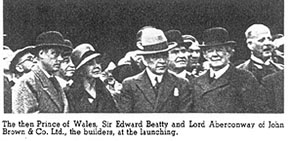 That
was on June 11, 1930. Twelve more months elapsed before builders, engineers
and decorators had finished with the new 42,348-ton addition to the British
Mercantile Marine and the ship was ready for her maiden voyage. On May 27,
1931, amid the widest acclamation, she set out on her first ocean trip.
That
was on June 11, 1930. Twelve more months elapsed before builders, engineers
and decorators had finished with the new 42,348-ton addition to the British
Mercantile Marine and the ship was ready for her maiden voyage. On May 27,
1931, amid the widest acclamation, she set out on her first ocean trip.
This was a triumph for her owners, builders and personnel, for, in spite of bad weather, the Empress used her 24 knots to good advantage and easily established a new record for the passage between Southampton, Cherbourg and Quebec, her time for the voyage between pilot stations at Cherbourg and Father Point being four days, 22 hours and 26 minutes. This record, however, did not stand for long, as in voyages favoured by better weather the big ship lowered her marks from time to time until a passage was made between Father Point and Cherbourg in four days, six hours and 58 minutes.
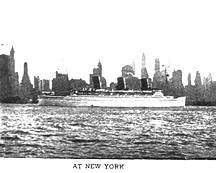 The
significance of the Empress of Britain to Canada and to the St. Lawrence route
in particular was tremendous. Her shining white bulk, propelled by the finest
machinery the marine engineers could design and offering the finality of luxury
and comfort to ocean travellers, was Canada's first challenge to the New York
route's monopoly of "super-ships." In nine summer seasons on this route, she
accumulated a total of well over half a million miles. Important was her performance.
Designed to maintain with one other ship a service that had previously needed
three liners, the Empress of Britain shouldered the major part of the burden
and, in short, acted as "an Atlantic ferry." Season after season, from 1931
until the outbreak of war in September, 1939, she made fortnightly departures
from either side of the Atlantic.
The
significance of the Empress of Britain to Canada and to the St. Lawrence route
in particular was tremendous. Her shining white bulk, propelled by the finest
machinery the marine engineers could design and offering the finality of luxury
and comfort to ocean travellers, was Canada's first challenge to the New York
route's monopoly of "super-ships." In nine summer seasons on this route, she
accumulated a total of well over half a million miles. Important was her performance.
Designed to maintain with one other ship a service that had previously needed
three liners, the Empress of Britain shouldered the major part of the burden
and, in short, acted as "an Atlantic ferry." Season after season, from 1931
until the outbreak of war in September, 1939, she made fortnightly departures
from either side of the Atlantic.
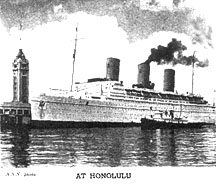
Empress of Britain boat trains became famous. As the Canadian Pacific was the only railway company in the world to own and operate trans-ocean steamers, so it had the only system where trains and ships were operated in co-ordination with a view to ensuring connections. Passengers leaving the Empress of Britain at Quebec, stepped aboard special trains bound for Montreal or Toronto on which were through cars routed to New York or Chicago. Sometimes, indeed, there were special through trains to Chicago. It all depended, of course, on the volume of business.
It was near the end of her life that the Empress of Britain touched the high point of her career, when Their Majesties King George VI and Queen Elizabeth sailed from Halifax aboard her at the end of their official Tour of Canada and visit to the United States (see next page for details).
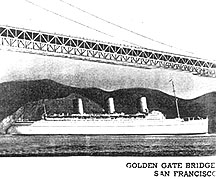
Less than three months after her proud voyage with the British monarchs on board, the British Empire was again at war with Germany. The day before Britain's declaration of war the Empress of Britain sailed from Southampton with a capacity passenger list, including hundreds of people fleeing back to their homes in Canada and the United States. That departure from Southampton on September 2, 1939, was the Empress of Britain's last commercial sailing. Soon after her arrival at Quebec, tons of dull grey paint began to accumulate at the dock and soon the gleaming white hull of the Canadian Pacific flagship, which had always made such a gay sight in the brilliant sunshine of world cruise ports, was converted into a dull grey mass -- the battleship grey prescribed by the British Admiralty for all ships in naval service during wartime. Porthole windows had already been temporarily blacked during her last voyage, now they were permanently covered and all her shining brasswork was smeared with grey.
She remained in Quebec until November, awaiting a call to serve the Empire under the flag of the Royal Navy. The call came, and on November 24, at another Canadian port she went under charter to the British Admiralty. She assisted in the transport of the First Division, Canadian Active Service Force, from Canada to Britain, and she helped bring the First Division of Anzacs from the Antipodes. She was also believed to have seen service in carrying troops between Britain and the Near East.
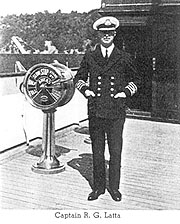 The
Empress of Britain steamed 858,436 miles in the service of the Canadian Pacific,
277,242 of this mileage being performed on World and West Indies Cruises.
Designed especially for world-cruise travel, she became the company's Round-the-World
Cruise ship in her first season, 1931-2, Captain R. G. Latta, who had commanded
the previous world-cruise ship, the Empress of Australia, taking her on her
30,000-mfle circumnavigation of the globe. In succeeding years she followed
the regular route of the Company's world cruises until 1936, when the Italo-Ethiopian
War and attendant tension between Britain and Italy caused an alteration in
her itinerary. The Mediterranean was avoided and instead the Empress of Britain
took her cruise company to South Africa and thence to India, there to resume
the regular cruise route.
The
Empress of Britain steamed 858,436 miles in the service of the Canadian Pacific,
277,242 of this mileage being performed on World and West Indies Cruises.
Designed especially for world-cruise travel, she became the company's Round-the-World
Cruise ship in her first season, 1931-2, Captain R. G. Latta, who had commanded
the previous world-cruise ship, the Empress of Australia, taking her on her
30,000-mfle circumnavigation of the globe. In succeeding years she followed
the regular route of the Company's world cruises until 1936, when the Italo-Ethiopian
War and attendant tension between Britain and Italy caused an alteration in
her itinerary. The Mediterranean was avoided and instead the Empress of Britain
took her cruise company to South Africa and thence to India, there to resume
the regular cruise route.
In
1938, the popular regular route was again followed, but in 1938 international
trouble, this time between Japan and China, affected the cruise, 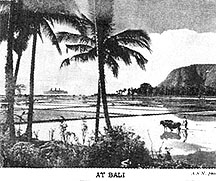 and
it was decided to send the flag- ship on the first visit any Canadian Pacific
ship had ever paid to Australia and New Zealand. This was carried out. The
Empress steamed on the regular route as far as Bali and then turned south
to the Australian continent. Calls were made at Sydney, Melbourne, Wellington
and Auckland, and also at Suva, capital of the Fiji Islands. Tumultuous welcomes
were accorded the great white liner at each port visited.
and
it was decided to send the flag- ship on the first visit any Canadian Pacific
ship had ever paid to Australia and New Zealand. This was carried out. The
Empress steamed on the regular route as far as Bali and then turned south
to the Australian continent. Calls were made at Sydney, Melbourne, Wellington
and Auckland, and also at Suva, capital of the Fiji Islands. Tumultuous welcomes
were accorded the great white liner at each port visited.
Her New Zealand visit established a record for a ship of her size and justified
the boast that she was the Symbol and Pride of the British Empire, for she
was then the only 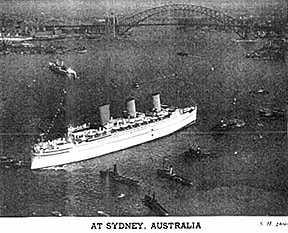 liner
that had visited all of the British Dominions Beyond the Seas, Canada, India,
South Africa, Australia and New Zealand, to which might be added as further
tokens of her Imperial standing the Crown Colonies of Gibraltar, Ceylon, the
Straits Settlements, Hong Kong, The Bahamas, Jamaica, Bermuda, Trinidad and
St. Helena. Her only visit to St. Helena was made during her final cruise,
in the winter of 1939, when, the war in China still dragging on, she was again
forced from the regular world cruise belt. This time it was decided that she
would revisit South Africa. She followed, therefore, the regular cruise route
to Bali and Java and then turned south and west for Durban and Capetown, carrying
on from there to St. Helena and on to Brazil, where she paid her first visit
to beautiful Rio de Janeiro. The last ports of her final world cruise were
Bahia, Port of Spain, Havana and New York.
liner
that had visited all of the British Dominions Beyond the Seas, Canada, India,
South Africa, Australia and New Zealand, to which might be added as further
tokens of her Imperial standing the Crown Colonies of Gibraltar, Ceylon, the
Straits Settlements, Hong Kong, The Bahamas, Jamaica, Bermuda, Trinidad and
St. Helena. Her only visit to St. Helena was made during her final cruise,
in the winter of 1939, when, the war in China still dragging on, she was again
forced from the regular world cruise belt. This time it was decided that she
would revisit South Africa. She followed, therefore, the regular cruise route
to Bali and Java and then turned south and west for Durban and Capetown, carrying
on from there to St. Helena and on to Brazil, where she paid her first visit
to beautiful Rio de Janeiro. The last ports of her final world cruise were
Bahia, Port of Spain, Havana and New York.
(above narrative & pictures from original CP Empress of Britain publicity material and passenger list)
| <<Previous | Home | Top |
Next
>>
|